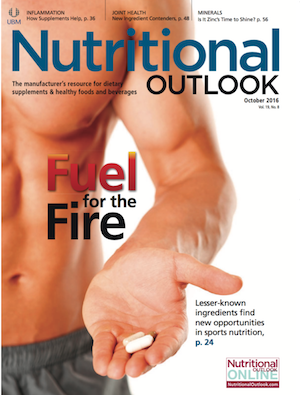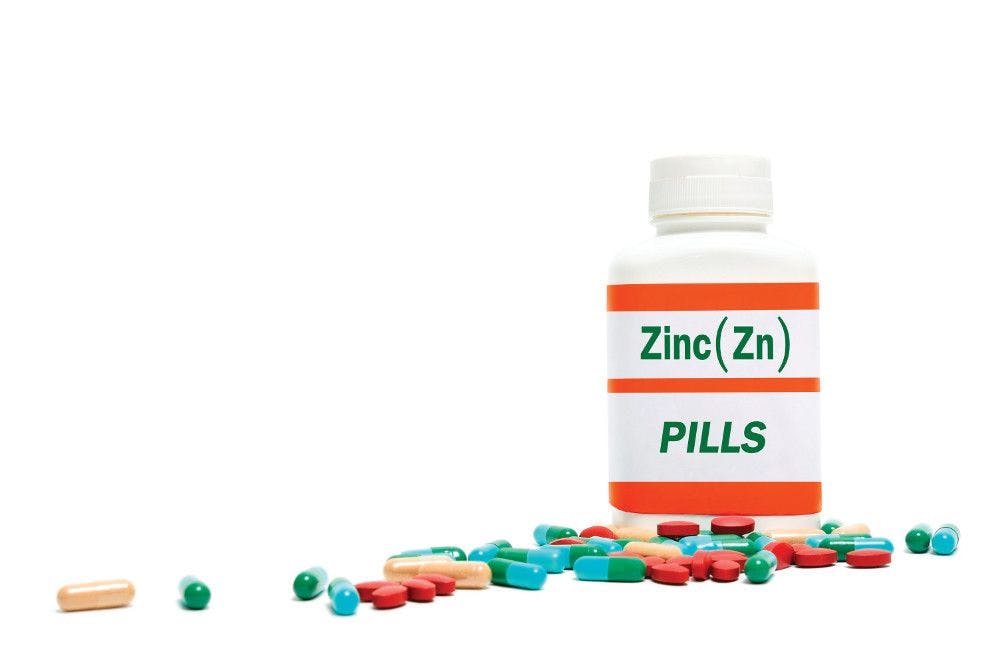Dietary Supplements and Inflammation
Can dietary supplements help manage the widespread effects of heightened inflammation?
Photo © Sebastian Kaulitzki/Shutterstock.com

When the movie “Concussion” hit theaters, it made an impact (and some enemies in the NFL) for revealing the damage that years of gridiron rough-and-tumble can inflict on players’ brains, their relationships, their lives. But while most viewers saw the film as a dramatized exposé of the dangers of contact sport, Harry B. Rice, PhD, vice president, regulatory and scientific affairs for the Global Organization for EPA and DHA Omega-3s (GOED; Salt Lake City), viewed its message through a different lens.
“Consider the handful of football players mentioned in the movie,” he says. “Mike Webster, Terry Long, Justin Strzelczyk, Andre Waters, Junior Seau: they committed suicide due to chronic traumatic encephalopathy, or CTE, a progressive degenerative disease found in people who have had a severe blow or blows to the head.” So even as their stories laid bare the tragedy of repeated head injury, they underscored the mechanism that renders those injuries so tragic over the long term: inflammation.
As Rice explains, “Neuroinflammatory processes apparently progress after the initial head injury and worsen with time.” Research now shows that inflammation from such injuries can instigate a number of chronic, debilitating conditions, not least of which are traumatic brain injury, Parkinson’s disease, Alzheimer’s disease, and-yep-CTE.
But that’s only the start. Studies link chronic inflammation to osteoarthritis, allergies, heart disease, diabetes-even some cancers. And while football players can look to rules changes for protection, evidence suggests that supplements can do the same for the rest of us. As Linda Doyle, senior vice president, global marketing, OmniActive Health Technologies (Morristown, NJ), says, “What’s exciting is that we have a better understanding of the relationship between inflammation and disease, the mechanisms involved, and the science on natural ingredients that can help.”
Inflammation Nation
If “Concussion” placed head injuries squarely on the public’s radar, the inflammation underlying them “has covered only half its journey” toward widespread relevance, says Shaheen Majeed, marketing manager, Sabinsa (East Windsor, NJ). Yet thanks to coverage (not to mention advertisements) on websites, blogs, social media, television, and the big screen, inflammation’s profile is growing. The upshot, says Majeed, is that more consumers “now take measures to prevent and manage inflammation with the intent of avoiding the chronic disorders” that it triggers.
Doyle sees a similar trend. Consumers have traditionally associated inflammation mostly with joint health, she notes, but the continued effort to call attention to inflammation’s broader consequences has left mainstream shoppers “increasingly aware of the relationship between inflammation and disease.”
When Good Inflammation Goes Bad
Of course, that relationship isn’t all black and white, as inflammation isn’t universally bad. There’s a reason our immune systems mount vigorous inflammatory responses when conditions warrant: such responses keep us alive, putting a defensive ring around pathogens, toxins, and garden-variety dead and damaged cells. Notes Rice, “My perception is that most people think inflammation is a dangerous thing, but inflammation is necessary for the body to heal itself after injury, or to protect itself against bacteria and viruses.”
Yet if healthy inflammation is a body’s best friend, inflammation cranked into overdrive is more trouble than it’s worth. One need look no further than the inflammatory components of, say, meningitis or inflammatory bowel disease (IBD) to understand that just as “an absence of inflammation would be deadly,” as Rice puts it, “the presence of inflammation can be deadly, too.”
Warning Signs
If nothing else, inflammation is unpleasant, with pain, heat, redness, and swelling all cardinal signs of its acute presence. But at the molecular level, clinicians and researchers monitor more sophisticated markers to determine whether or not inflammation has gone dangerously chronic. Cyclooxygenases (COX), tumor necrosis factor alpha (TNF-α), prostaglandin E2 (PGE2), thromboxane A2 (TXA2), leukotriene B4 (LTB4), C-reactive protein (CRP), monocyte chemoattractant protein-1 (MCP-1), matrix metalloproteinases (MMPs), and interleukins (IL)-1, IL-6, and IL-8 all “give us a detailed perspective of the grade or extent of inflammation,” Majeed says.
Once that grade and extent reach a breaking point, chronic diseases ranging from metabolic syndrome and rheumatoid arthritis to pulmonary disorders and depression surface.
Botanical Benefits
“As an aging population confronts these diseases, the increasing demand for dietary supplements targeting inflammation is understandable,” says Eric Anderson, senior vice president, global sales and marketing, NattoPharma USA Inc. (Metuchen, NJ), North American subsidiary of NattoPharma ASA (Oslo, Norway).
Thanks to research into the mechanics of inflammation, the means by which supplements target inflammation are increasingly understandable, too. “Broadly speaking,” Doyle explains, “supplements help reduce inflammation by interacting with biochemical and messenger pathways that regulate-or dysregulate-inflammation.”
In vitro and in vivo human clinical studies bear this out, with results indicating that plant-sourced bioactives may “prevent and manage a host of inflammatory-related conditions,” Majeed notes. He points to clinical evaluations of such natural supplements as curcuminoids, ginger extract, and boswellia extract, to name a few, that find a “significant role” for these ingredients in managing inflammation-associated conditions.
Take boswellia. A product of the same plant that gives us Indian frankincense (Boswellia serrata), boswellia extract is rich in boswellic acids, the pentacyclic triterpenes that are its active components. “The anti-inflammatory property of boswellic acid is due to its unique ability to block two pro-inflammatory enzymes: 5-lipoxygenase and human leukocyte elastase,” Majeed says. “This mechanism is much like conventional non-steroidal anti-inflammatory drugs, or NSAIDs,” but without side effects like stomach irritation and ulceration.
His company produces a powdered extract sold as Boswellin that’s standardized to contain β-boswellic acid, acetyl-β-boswellic acid, 11-keto-β-boswellic acid, and acetyl-11-keto-β-boswellic acid. In a 48-subject, double-blind, randomized, parallel-group, placebo-controlled internal company study investigating the extract’s effect on arthritis symptoms, researchers found a statistically significant reduction in clinical symptoms-pain, stiffness, physical function-in the treatment group as compared to the placebo, Majeed says. Improved scores on the WOMAC osteoarthritis index and visual-analog pain scale (VAS), plus longer distances covered in six-minute walk tests, “further confirm” the extract’s utility, he concludes.
Ancient Traditions
Majeed notes that India’s Ayurvedic medical tradition has long deployed botanicals like boswellia against arthritis and related inflammatory conditions. Another tool in its arsenal is ginger extract (Zingiber officinale) and the gingerols that are its major bioac-tive compounds.
While ginger extract’s use as an anti-inflammatory “has been well documented throughout history,” Majeed says, “we now know that its mechanism of regulating inflammation is to inhibit prostaglandin biosynthesis,” specifically of COX-1 and COX-2. “Ginger additionally suppresses the immune system’s production of pro-inflammatory cytokines and chemokines,” he adds, “reducing disease severity in patients with inflammatory conditions such as rheumatoid arthritis [RA].”
As far as managing the more commonly experienced osteoarthritis (OA) goes, Majeed cites a 2005 double-blind, randomized, placebo-controlled study1 that compared the effects of ginger extract against the NSAID ibuprofen and a placebo in 120 outpatients with moderate to severe arthritis pain. After one month of treatment, VAS scores and reports of regressive pain after rising were significantly lower in both the ginger and ibuprofen groups than in those taking the placebo-indicating not only that ginger extract helps manage arthritis pain, but that it does so as effectively as ibuprofen.
Another staple of Ayurvedic medicine-and another botanical in the anti-inflammatory armamentarium-is turmeric extract (Curcuma longa) and its constituent curcuminoid actives. As Majeed explains, curcumin’s anti-inflammatory effect is attributed to its suppression of NF-kappaB (NF-κB), a protein complex that controls DNA transcription, cytokine production, and cellular survival. “Through this suppression,” he says, “curcuminoids reduce pain and inflammation.”
Daily supplementation with Sabinsa’s Curcumin C3 Complex-standardized to contain no less than 95% curcuminoids and to be particularly rich in curcumin, demethoxycurcumin, and bixdemethoxycurcumin-was the subject of a six-week, double-blind, placebo-controlled study2 whose 40 participants had mild to moderate osteoarthritis of the knee. The curcumin complex proved “effective in alleviating pain associated with OA, as evaluated by significant reduction in WOMAC scores,” Majeed notes, “especially with respect to significant improvement in pain and physical-function scores.” Researchers similarly observed a reduction in VAS and Lequesne’s pain functional index scores, and a significant reduction in patient painkiller dependence.
While the results of such studies aren’t exactly common knowledge, Doyle notes that “consumers are well aware of the benefits of supplementing with curcuminoids.” Her company, OmniActive, may claim some credit for putting it on the map, as it’s undertaken “an exhaustive amount of preclinical work, including nutrigenomics; enzyme assays; in vitro, dose testing, interaction, and safety studies; and a battery of toxicological studies to characterize metabolic targets and cellular uptake” of the curcumin, she says.
For example, OmniActive presented findings at Experimental Biology this year demonstrating the influence of its branded CurcuWin extract on endothelial dysfunction, a key indicator of heart disease. It also presented a patent on the product detailing a “landmark” animal study that shows the ingredient’s implications for brain and mood health. “Our robust clinical program is exploring more novel uses for the product,” she adds, “including heart health, cognitive function, diabetes, and exercise performance, to name a few.”
And because bioavailability “has been an area of focus,” Doyle says, her company uses what it calls its UltraSol delivery system to increase the extract’s solubility and bioavailability, dispersing the curcumin into a powder purified to 95% curcuminoids and blending it with a water-soluble carrier, food-grade excipients, and antioxidants to protect its actives. An internal bioavailability study using a pharmaceutical design and analytical methods found absorption 46 times greater compared to standard curcumin and significantly greater than that achieved with other enhanced forms, she says.
Friendly Fats
Botanicals like curcumin are promising, but they’re not the only effective anti-inflammatory supplements in town. Indeed, a full accounting of the range of supplements that address inflammation exceeds the scope of this article. But among the more extensively studied are the long-chain polyunsaturated omega-3 fatty acids (PUFAs) eicosapentaenoic acid (EPA) and docosahexaenoic acid (DHA).
GOED’s Rice believes EPA and DHA stand out thanks to their “long history of safe use coupled with an impressive portfolio of research results supporting their anti-inflammatory benefits.” Consider what goes on in Alzheimer’s disease. “There are many hypotheses about its causes,” Rice says, “and the inflammatory theory is one of them. If true, keeping acute inflammation from progressing to chronic inflammation with EPA and DHA could very well result in maintaining cognitive health throughout life.”
There’s also “high-quality research” demonstrating an EPA/DHA benefit with regard to rheumatoid arthritis, such as a 2015 study3 showing that “individuals with rheumatoid arthritis taking omega-3s demonstrated significant improvement and were able to reduce their analgesic medication versus a placebo,” Rice notes.
What these PUFAs are actually doing “is a somewhat difficult question to answer,” Rice concedes. “While EPA/DHA are associated with many benefits, the exact mechanisms of action are unknown for most.” For perspective, he directs readers to a 2015 publication4 by Tucson, AZ–based omega-3 researcher Ann Skulas-Ray outlining “the challenges associated with evaluating the efficacy of omega-3s in clinical research,” he says.
And while he finds much research to date encouraging, he “would not qualify the evi-dence as indisputable,” he says. Further, omegas are “unlikely to benefit every known inflammatory condition.” Case in point: Rice notes that lipid scientist Philip Calder wrote in a 2015 review5 on omega-3s and inflammatory processes that “[C]linical trials of fish oil in RA demonstrate benefit, but clinical trials of fish oil in IBD and asthma are inconsistent, with no overall clear evidence of efficacy.” Translation: watch this space for more.
A Novel Path to Cardiovascular Health
NattoPharma’s Anderson notes that one nutrient heretofore associated mainly with maintaining calcium balance in bones and blood vessels is now garnering attention for fighting inflammation. That nutrient is vitamin K2, or menaquinone, and while this “is an early area of research” for the vitamin, Anderson says, “the results thus far are promising.”
For instance, by testing and confirming that the longer-chain menaquinone-7 form of vitamin K2 helps modulate certain immune and inflammatory biomarkers, a study6 published this year in the Journal of Medicinal Food successfully demonstrates yet another path by which the vitamin supports cardiovascular health.
It sounds like a roundabout conclusion, but as the study’s authors note, cardiovascular disease “is not only considered a disorder of lipid accumulation, but also a disease characterized by low-grade inflammation of the endothelial cells and an inappropriate healing response of the vascular lining.” That prompted the researchers to investigate the ability of high-purity natural vitamin K2 (98.4% MK-7 from NattoPharma) to inhibit gene expression and production of pro-inflammatory markers in human monocyte-derived macrophages (hMDMs) from two sources (hMDMs and THP-1).
Sure enough, MK-7 did show a dose-dependent inhibition of the in vitro gene expression and production of inflammatory markers TNF-α, IL-1α, and IL-1β in healthy hMDMs. “In view of these encouraging findings on the anti-inflammatory properties of MK-7,” the researchers write, “we plan to test additional biomarkers of immune and inflammatory response in this form of vitamin K2 in vitro.” In so doing, they hope to tease out vitamin K’s anti-inflammatory mechanism and establish potential biomarker targets for the clinical testing of MK-7 in cardiovascular health and other chronic conditions. And if similar effects emerge in vivo, they added, “It will be very beneficial for people who need to be on anti-inflammatory treatment.”
Inflammatory Statements
Despite the promise of these natural interventions, supplement marketers will need to be very careful in communicating their effects to consumers. “Key here is that anti-inflammatory supplements ‘reduce’ inflammation,” Doyle says. “They don’t stop it. So supporting healthy inflammation is an important aspect of supplements.”
Just ask FDA, which regards inflammation-related health claims as drug claims unless they’re crafted specifically as structure/function statements referring to the process of modulating the normal inflammatory response. In other words, Doyle says, “Claims must be made for ‘normal functioning,’ and disease endpoints must not be involved in claims or studies that support compliant health claims.”
Even so, “Consumers, for the most part, are more interested in products that address specific needs,” she says. That means that statements like “supports heart health” or “supports joint health” carry more weight than “supports healthy inflammation.” But as consumers grow savvier about the inflammation-disease relationship, Doyle insists, “They will pay more attention to inflammation as part of a lifestyle and supplement reg-imen to mitigate its effects.” And we’ll all be better off as a result.
Also read:
EPA versus DHA Omega-3s for Inflammation: New Study Results
Inflammation and Anti-Inflammatory Diets
Collagen Peptides Reduce Joint Inflammation, Support Cartilage Regeneration, Animal Study Suggests
References:
- Masoud Haghighi et al., “Comparing the effects of ginger (Zingiber officinale) extract and ibuprofen on patients with osteoarthritis,” Archives of Iranian Medicine, vol. 8, no. 4 (August 2005): 267–271
- Panahi Y et al., “Curcuminoid treatment for knee osteoarthritis: a randomized double-blind placebo-controlled trial,” Phytotherapy Research, vol. 28, no. 11 (November 2014): 1625–1631
- Rajaei E et al., “The effect of omega-3 fatty acids in patients with active rheumatoid arthritis receiving DMARDs therapy: double-blind randomized controlled trial,” Global Journal of Health Science, vol. 8, no. 7 (November 3, 2015): 52769
- Skulas-Ray AC et al., “Omega-3 fatty acids and inflammation: a perspective on the challenges of evaluating efficacy in clinical research,” Prostaglandins and Other Lipid Mediators. Published online February 16, 2015.
- Calder PC, “Marine omega-3 fatty acids and inflammatory processes: effects, mechanisms and clinical relevance,” Biochimica et Biophysica Acta. Published online August 20, 2014.
- Pan MH et al., “Inhibition of TNF-α, IL-1α, and IL-1β by pretreatment of human monocyte-derived macrophages with menaquinone-7 and cell activation with TLR agonists in vitro,” Journal of Medicinal Food. Published online May 20, 2016.

Prinova acquires Aplinova to further increase its footprint in Latin America
April 7th 2025Prinova has recently announced the acquisition of Brazilian ingredients distributor Aplinova, which is a provider of specialty ingredients for a range of market segments that include food, beverage, supplements, and personal care.

























